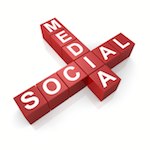The Frightening Social Media Gap in Doctor Marketing
 Physicians are well acquainted with social media. As a group, doctors use Twitter, Facebook, LinkedIn and similar platforms even more actively than the public at large. But for doctors, “social media” is primarily confined to a professional circle of connections that—with few exceptions—largely excludes doctor-patient communications.
Physicians are well acquainted with social media. As a group, doctors use Twitter, Facebook, LinkedIn and similar platforms even more actively than the public at large. But for doctors, “social media” is primarily confined to a professional circle of connections that—with few exceptions—largely excludes doctor-patient communications.
Physicians are connecting with professional colleagues, tapping into information about medical advances, and using social media for networking and job-finding. And, to their credit, many physicians and hospitals are integrating some form of social media in their healthcare marketing.
Overall, the numbers show a frightening contrast. For personal use, according to a study by online physician community QuantiaMD, 87 percent of physicians use at least one social media site. But physician-patient interaction is a different story. Only 15 percent of physicians are on Facebook professionally…and the numbers for other social media sites are mere single digits.
While important considerations direct this inward-facing posture, it puts US doctors and healthcare organizations on the trailing side of a social media gap compared to many other countries. [See: Should Healthcare Organizations Use Social Media? PDF] What’s more, this comprehensive report by CSC also sees healthcare trailing the corporate world on the social media adoption curve.
Social Media Applications in Healthcare
In addition to connecting with colleagues, tracking medical advances and the general category of marketing, the CSC report lists a number of social media applications including:
- Workforce Recruitment;
- Brand Management;
- Reputation Management;
- Consumer Education;
- Professional Education;
- Healthcare Community Creation;
- Clinical Trial Recruitment; and
- Research Collaboration.
A Warning (and Opportunity) for Physicians, Providers and Hospitals
Providers in the US can’t afford a wait-and-see attitude, cautions CSC. Social media can be used to accomplish healthcare goals in four broad areas: communications, information sharing, clinical outcomes and speed of innovation.
But there’s an opportunity to follow other nations, and use social media more actively in patient care, including wellness, population and patient monitoring, care management and care coordination. “More broadly,” CSC recommends, “organizations should develop an overarching strategy that leverages social media to help influence customers and accomplish strategic healthcare goals.”
One interactive example is the UK’s social networking site, How Are You? which is a free service that brings together National Health Service [NHS] patients and healthcare professionals. [Admittedly a different health system, but check out the demo here.] Primary features include Personal Health Planning, a Personal Health Record section, and the means to find and interact with local health services and professionals.
Some hospitals, health systems and health insurance programs in the United States are undertaking similar, “overarching” and comprehensive connections among patients, providers and the healthcare delivery system. The benefits of closing this social media gap include improved outcomes, better patient-physician communications and an enriched patient experience.
Do you have a social media plan in place? Is it keeping pace with others?
See how Healthcare Success transforms doctor marketing by generating exposure and increasing qualified leads!
Related Articles:
Nothing Personal, but Doctors Still Fear Social Media in Physician Marketing
Making Social Media Easy (and Beneficial) for Doctor Marketing
5 Things Most Doctors Get Wrong about Social Media
16 Internet Social Media Gathering Spots for MDs; Listening-posts for Doctor/Physician Marketing
3 Top Reasons Why Doctors Need to Keep an Open Mind About Social Media









